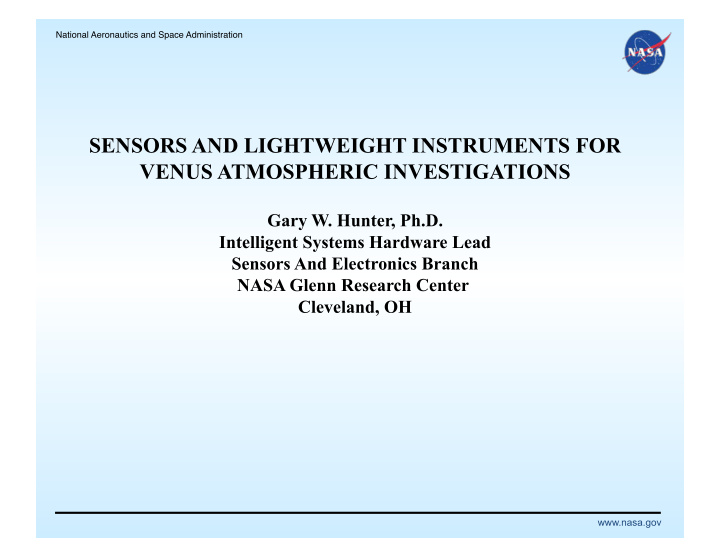



National Aeronautics and Space Administration � SENSORS AND LIGHTWEIGHT INSTRUMENTS FOR VENUS ATMOSPHERIC INVESTIGATIONS Gary W. Hunter, Ph.D. Intelligent Systems Hardware Lead Sensors And Electronics Branch NASA Glenn Research Center Cleveland, OH www.nasa.gov
National Aeronautics and Space Administration � BRIEF SCIENCE OVERVIEW www.nasa.gov
National Aeronautics and Space Administration � Example Proposed Instrumentation for Atmosphere Studies Venus STDT Section 4.3.2 www.nasa.gov
National Aeronautics and Space Administration � Scientific Objectives for the Exploration of Venus by Aircraft Venus STDT Section B2.1 • The determination of atmospheric properties over a region of the atmosphere. • Direct sampling and analysis of the atmosphere. • Characterization of trace gasses as possible biogenic indicators of life. • Searching for volcanic emissions in specified regions of the planet. • Magnetic field mapping over a region of the planet. • Platform for radar investigations of the surface. • Magneto-telluric sounding of the interior. • Correlation of atmospheric motion between different locations by two or more aircraft. • Communications and command relay for balloons, landers, and possible surface vehicles. www.nasa.gov
National Aeronautics and Space Administration � OVERVIEW • FLIGHT CONDITIONS SIMILAR TO THAT OF EARTH FLIGHT MISSION EXCEPT: HIGH WINDS SULFUR CONTENT • COMPLEX AND LARGER INSTRUMENTATION EXISTS HIGH CAPABILITY SYSTEMS IMPLEMENTATION MAY BE CHALLENGING DEPENDING ON THE ATMOSPHERIC FLIGHT PLATFORM USED • SIGNIFICANT AMOUNT OF TERRESTRIAL ATMOSPHERIC SCIENCE EXPLORATION ON- GOING; DECREASE IN SIZE, WEIGHT, AND POWER ON-GOING • THIS PRESENTATION GIVES A BRIEF OVERVIEW OF SMALLER, LIGHTWEIGHT SYSTEM’S THAT MIGHT BE USED FOR VENUS ATMOSPHERIC INVESTIGATIONS TARGETED TOWARD SCIENCE OBJECTIVES CORE SUGGESTION: SMALLER SYSTEMS MAY ADDRESS ASPECTS OF SCIENTIFIC QUESTIONS WHILE BEING MORE APPROPRIATE FOR SOME AERIAL PLATFORMS IN EACH CASE, MODIFICATION FOR VENUS ENVIRONMENTS NEEDED www.nasa.gov
National Aeronautics and Space Administration � MEMS GAS SENSOR ARRAY • PLACEMENT OF SENSORS SIGNIFICANTLY CLOSER TO THE ENGINE OUTLET THAN TRADITIONAL EQUIPMENT ALLOW REPLACEMENT OF INSTRUMENT RACKS • PROVIDE MEASUREMENTS IN APPLICATIONS WHERE SYSTEMS SUCH AS MASS SPECTROMETERS WOULD BE PROBLEMATIC • PRESENT WORK INCLUDE MEASURING ENGINE EMISSIONS FOR DETERMINATION OF ENGINE HEALTH Packaged Sensor Sensor Array Engine Data At Rolls-Royce Rake Sampling System At The Outlet Of The JT-12 Jet Engine. www.nasa.gov
National Aeronautics and Space Administration � VENUS APPLICATION DEVELOPMENT Phase I SBIR • LEVERAGE MEMS-BASED SENSOR DEVELOPMENT FOR VENUS APPLICATIONS • OPERATIONAL OVER A BROAD RANGE OF APPLICATION ENVIRONMENTS • TARGETED TOWARD DROP SONDE APPLICATIONS FOR BOTH ATMOSPHERIC AND SURFACE MEASUREMENTS PROFILING CHEMICAL COMPOSITION OF THE VENUS ATMOSPHERE IN A DROP SONDE PROVIDING GAS COMPOSITION MEASUREMENTS AS PART OF THE LONG LIVED LANDER WITH METEOROLOGICAL MONITORS. Examples of packaged MEMS based sensors www.nasa.gov
National Aeronautics and Space Administration � VENUS SCIENCE APPLICATION • FOR APPLICATION RANGES WHERE MORE COMPLEX INSTRUMENTS ARE CHALLENGED BY SIZE OR WEIGHT CONSIDERATIONS • COULD BE COUPLED WITH A DROP SONDE TO COMBINE MONITORING OF SPECIES AT HIGHER ATMOSPHERES WITH A PROFILE DOWN TO THE SURFACE • A RANGE OF SPECIES OF INTEREST HAVE BEEN INDENTIFIED • MULTIPLE SENSOR DESIGNS TESTED • MOST MATURE SYSTEMS NO, CO, O2, H2O, H2 AND SOx • DESIGNS FOR OTHER SPECIES INVESTIGATED • ARRAY AIMED TOWARDS A SMALLER FOOTPRINT THAN MORE COMPLEX SYSTEMS 8 TO 12 SENSOR ARRAY: ~200 gm , 4 cm X 4 cm X 4 cm, ~ 1 W www.nasa.gov
National Aeronautics and Space Administration � MINIATURIZED PARTICULATE SENSOR • PRINCIPAL ELEMENT: MONOBLOC OPTICAL ASSEMBLY HOUSINGTRANSMITTING AND RECEIVING OPTICS • APPROACH HERE UTILIZES MULTIPLE, FIXED-ANGLE SCATTERING MEASUREMENTS ALLOW DETERMINATION OF MULTIPLE DISTRIBUTION PARAMETERS FLIGHT QULAIFIED/FLOWN ON ISS TOOLKIT OF TECHNOLOGIES FOR A WIDE RANGE OF PARTICULATE SIZES/SHAPES MOVING TOWARDS UAV IMPLEMENTATION VENUS SCIENCE APPLICATIONS DIRECT SAMPLING AND ANALYSIS OF THE ATMOSPHERE INCLUDING MEASURING, CHARACTERIZING, AND MONITORING ATMOSPHERIC PARTICULATES IN REAL TIME. RECOGNIZES THE SPECIFIC PROPERTIES OF AN UNKNOWN AEROSOL AND MEASURES THE TOTAL MASS AND SURFACE AREA OF A GIVEN AEROSOL CLOUD . MULTIPARAMETER AEROSOL OPTICAL PARTICULATE SENSOR SCANNING SENSOR PACKAGE www.nasa.gov
National Aeronautics and Space Administration � Airborne Hyperspectral Imager Designed for Aircraft Implementaiton • Great Lakes Ecology: Monitoring Harmful Algal Blooms (HABs) in fresh water ecosystems – Great Lakes Environmental Research Lab • Ecological change: Monitoring change of dry forest and coral reef ecosystems – University of Puerto Rico at Mayaguez • Invasive Species: Measure the spread of invasive plant species in the Detroit River International Refuge – Eastern Michigan University Fundamental Research: 2006 - 2011 Processed HSI data of Microcystis Bloom with higher concentrations GRC and GLERL have demonstrated HSI capable of detecting indicated by red and sediment is in HABs in low concentrations - key capability for bloom blue (0.8 km x 1.4 km) prediction Venus Science Application: The Great Lakes When included with an upward looking irradiance sensor, contain 18% of it is possible to determine localized atmospheric the world’s fresh constituents by measuring spectral reflection and surface water and 90% of the U.S. absorption of atmospheric and surface features supply Two generations of GRC airborne HSI’s http://www.glerl.noaa.gov/res/Centers/HumanHealt/ www.nasa.gov 10 10
National Aeronautics and Space Administration � Cloud and Earth’s Radiant Energy System (CERES) • Researchers from GRC and LaRC are working together on CERES follow-on sensors • Multiple new technologies are being developed and tested for future missions, with a focus towards high yield sensor technologies • Sensor is measuring total radiance in a band from 400 nm to 100 microns. • Additional sensors could be included for measuring specific wavelength bands. VENUS SCIENCE APPLICATIONS • Instruments very similar to those presently flown to measure the Earth’s Radiation budget could be included in a Venus high altitude platform to determine radiant energy contributions from the lower atmosphere and surface. This would also allow for the study of the upper atmosphere contributions when studied concurrently with an orbiter. • Sensors would be tailored to operation in the Venus upper atmosphere www.nasa.gov 11
Recommend
More recommend